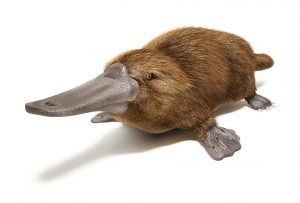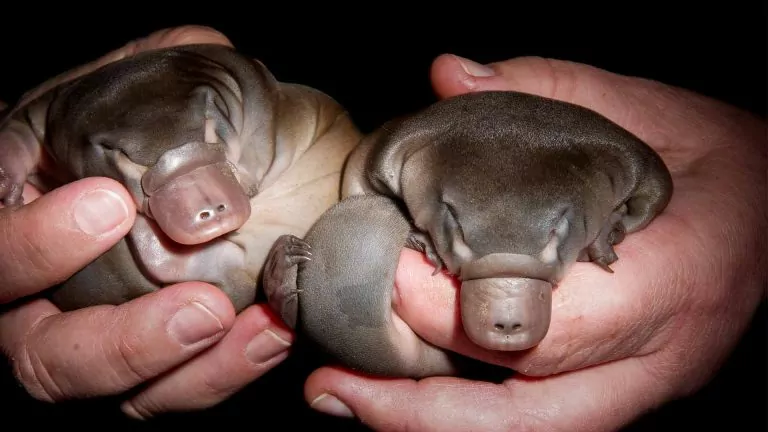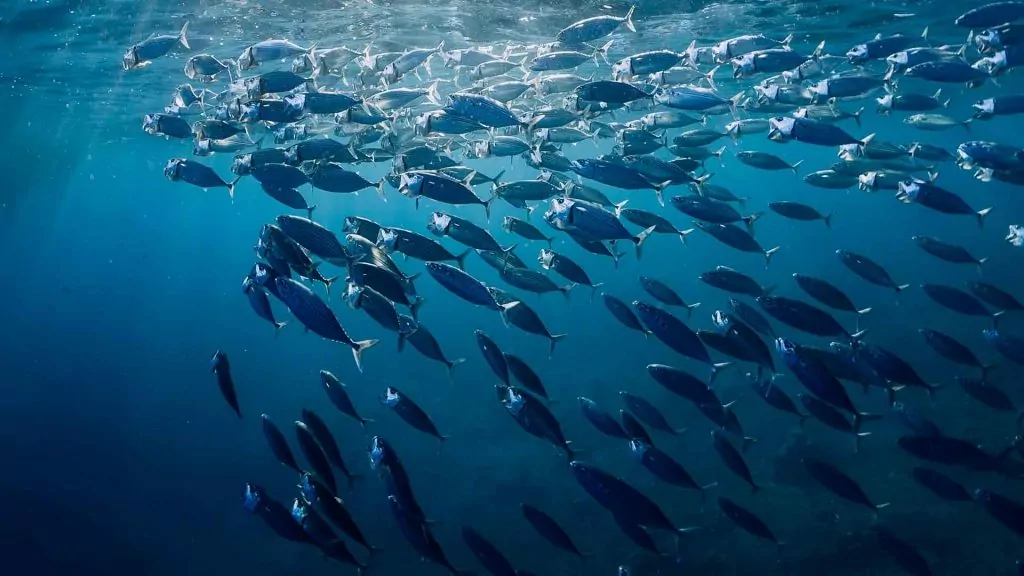In recent years a strange assortment of animals, some familiar and some obscure, have enjoyed a brief moment of scientific attention. In each case, the occasion for this special fame was the publication of the genome – the complete DNA sequence – of that organism. In May 2008, the genome of Australia’s platypus was published. This creature is justly famous anyway, but the genome studies have helped focus attention on why this is so.
Not a hoax
When British naturalists first saw a pelt of a platypus, they were sure it was a hoax. With its thick fur, webbed front feet and duck bill-like snout, it certainly did not resemble any other animal known at the time. Further study showed however that the animal is perfectly genuine. Eventually, naturalists discovered that this animal lays eggs, but yet it suckles its young with genuine mother’s milk. It seemed as if this creature was a strange jumble of bird, reptile and mammalian (feeds milk to young) characteristics. More careful study however reveals that this organism is actually a beautifully designed entity.
The duckbilled platypus remains a highly unusual creature. Not only its appearance, but many aspects of its biology are unique. These small animals (up to 60 cm long) spend most of their time underwater. Indeed they are able to find food only when submerged. Amazingly, however, they swim blind, deaf and without the normal opportunity to detect odors since flaps cover their eyes, ears and nose while they are submerged. Recent research however has revealed that they have some unique abilities to compensate for lack of sight, hearing and smell.
Once the genome data has been collected, there is nothing obvious to show what stretches of DNA contain genes of interest. The number of nucleotides in the platypus genome is 2.3 billion, quite close to the 3 billion contained in the human genome. The number of protein-coding genes thus far identified in platypus is also similar to the number in humans: 18,600 for platypus compared to about 25,000 for humans. Faced with endless arrangements of nucleotides, how do scientists “read” the information contained therein?
What scientists did was to start slowly in their early genome studies with attempts to identify sections coding for certain basic genes. Gradually they built up a computerized repertoire of DNA coding which identifies important genes in at least one organism. Then when they wish to study a different organism, they use huge computers to look for similar stretches of DNA in the new organism. Fancy mathematics allows the computer to decide whether similar sequences are close enough to represent the same gene or not.
Since the genomes of many organisms have now been documented, scientists now have a large collection of nucleotide sequences that code for important genes. The interesting thing then is to compare how the new organism resembles other creatures and ways in which it differs. Does it have similar genes or different ones? This analysis certainly reveals interesting things about the platypus.
Gender and reproduction
Genome analysis shows that gender determination in platypus is unique among milk-producing organisms. Rather than X and Y chromosomes such as we normally see in milk producers, gender in platypus is determined by chains of tiny chromosomes. Females have five pairs of tiny X chromosomes, while males have 5 pairs of X chromosomes plus five tiny Y chromosomes.
The really interesting thing is that the genetic information on the X chromosomes is nothing like that in other milk-producing creatures. The information, in fact, is faintly similar to the Z chromosome which determines gender in birds. Scientists are totally astonished by this feature of the platypus genome.
Unlike other milk producers, platypus and echidnas have just one opening at the rear end of the body. Other milk producers have an opening from the digestive system plus a combined one for urine and reproduction. Platypus and echidnas have one combined opening for everything called the cloaca (like birds and reptiles).
But platypus has a unique way of producing young, not at all like birds or reptiles. The female keeps the fertilized eggs inside her body for 21 days. Meanwhile, she seals herself into a small chamber lined with vegetation at the end of an 8-meter long tunnel dug into the bank of a lake or stream. There she lays 1 or 2 tiny sticky, leathery eggs. These she incubates until they hatch in about 11 days.
Initially only about the size of jelly beans and lacking developed organs and an immune system, the young suckle milk through pores on their mother’s abdomen. After 4 months, the young become independent. The eggs, it is well known, divide in a manner similar to birds and reptiles and as a result, contain a yolk. However recent genome research reveals that the milk is very similar in composition to that of other mammals.
Underwater navigation
Recent research has revealed how the platypus is able to find food despite the fact that its ears, nose and eyes are closed underwater. Obviously the creature needs special hardware and talents designed for navigation. Thus it was that in 1985 German scientist Henning Scheich discovered some highly unusual properties of the platypus. This animal reacts to weak electrical fields in water.
What this scientist did was bury a small charged battery under a brick in the water. In addition, he placed a similar, but dead battery under another brick. The platypus dislodged the brick sitting on top of the charged battery, but it ignored the other brick/battery site. Later, the platypus avoided a mesh screen placed in front of a charged battery, but it collided with a screen placed in front of a dead battery. Further studies have amply confirmed that platypus have electroreceptors in their bills.
As sensitive as a star-nosed mole
 Since the late 1980s, scientists have discovered that there are two kinds of electroreceptor and one type of touch receptor in the platypus snout.
Since the late 1980s, scientists have discovered that there are two kinds of electroreceptor and one type of touch receptor in the platypus snout.
At the front edges of the bill, there are tiny pores containing a membranous receptor. Moreover, over the main surface of the bill there are oblique stripe-like arrays of pores which are mucous-filled. The mucous serves to enhance transmission of a signal to the nerve at the bottom of the pit.
The bill of the platypus has 40,000 electroreceptors, while in comparison the 2 species of its closest cousin, the echidna, boast only 2000 and 400 respectively. Mapping of sensors was conducted on anesthetized animals. Electrical sensors were attached to the exposed cortex of the brain, and electrical and mechanical stimuli were applied to the bill. The resulting signals in the cortex were duly noted as were the locations in the bill where the sensitive pores were located.
The push-rod mechanical (touch) receptors in the bill are remarkable in their own right. Inside the pore is a compacted column of skin which can rotate about its base or move up and down.
These very sensitive touch receptors are similar to the highly unusual touch receptors in the nose of the star-nosed mole. The organ of touch in the snout of the star-nosed mole is so sensitive, that the information obtained from it is almost as detailed as vision. This animal also spends most of its time foraging for food in the water. Until recently, scientists knew of no other creatures with as sensitive a sense of touch. Now it appears that the mechanoreceptors in the bill of platypus are of even more sophisticated design.
There is yet another interesting feature of these sensory pores on the bill of the platypus – each is surrounded by petal-like skin flaps which open when the animal is underwater. When the animal emerges from the water, however, tiny sphincters around each pore close the flaps so that the sensors will not dry out.
The food which the platypus seeks are small animals living near or in the bottom sediments of lakes, ponds, or rivers. These animals favor some larvae of insects, worms, small crustaceans and other invertebrates. Apparently, these small creatures generate weak electrical fields as they move or simply maintain the processes of life in their bodies. With its electroreceptor capabilities, it seems that platypus can detect the field generated by a freshwater shrimp that is 10 centimeters away. Scientists suspect that the platypus knows how far away an electrical source is, whether it is moving, and in what direction it is proceeding.
More and more talents
The remarkable thing is that these sensory talents of platypus are so unique. As far as electrical sensing of the environment is concerned, some fish also exhibit this ability. However, in the case of fish, the sensors are all over the body and they are not nearly so sensitive.
But platypus has more talents yet! One might have imagined that platypus would not need much in the way of a sense of smell since their noses are closed under water. This conclusion is partly right and partly wrong. As far as genes for normal smell (chemical receptors) are concerned, the genome project shows that platypus has a reduced number of receptor types (only about half of what most mammals exhibit). However, there are chemical receptors called vomeronasal receptors which may be located in the mouth or the nose and surprise, surprise, platypus has the largest variety of vomeronasal type 1 receptors known. At 950 different variations on the vomeronasal type 1 receptor (V1R) the platypus has 50% more than the mouse. Compare this to the chicken, which has no such receptors. Nor, for that matter, do people.
The platypus thus has very special electrical, touch and chemical (taste) receptors. The article on the platypus genome published in Nature (May 8/08) discusses the large number of genes which code for the special chemical receptors (V1R). But the article makes no mention of genes for electrical and touch receptors. Obviously, there must be quite a number of genes in the platypus coding for components of these sophisticated sensors. However, the sequence (order) of nucleotides does not come with labels identifying which sections code for what. Scientists need an already established standard order of nucleotides coding for such genes from another, not too different creature. Since these talents are highly unusual, however, no comparison with a similar gene in a similar creature can as yet be made. Thus we don’t hear about how many genes code for electrosensory abilities and for extremely sensitive touch.
Defense: immunity and venom
Besides food and reproduction, an animal in nature needs to defend itself against larger animals and against microbes. The newly hatched young have only partially developed organs. They have no spleen, no thymus and no killer T and B cells which provide acquired immunity.
They do, however, exhibit a very unusual number of natural killer receptor genes. A natural killer is a precisely shaped molecule which is able to recognize other types of molecules characteristically produced by disease-causing organisms but not by the host organism itself. This capacity to stop a large number of common disease agents in their tracks is programmed into the genes of platypus and most other organisms as well.
However, since the platypus young are so small and vulnerable, it makes sense that these animals are provided with an unusually large variety of natural killer-type molecules (coded for on appropriate genes). The platypus thus has 214 genes for different variations on the natural killer theme compared to only 45 for rat, 9 for opossum and 15 for humans.
In addition, platypus is unusual among mammals in that the male is able to deliver a venom potent enough to kill a dog. There are only a few mammals which are venomous, but all of the others transmit the venom by means of a bite. The platypus, on the other hand, has spurs on its hind legs which deliver the venom. That venom is a cocktail of at least 19 different substances which exert various nasty effects on the victim.
God’s creativity and intricate design
Secular scientists have long declared platypus to be a strange blend of reptilian, bird and mammal (milk producer) characteristics. Such people consider that the genome study has further confirmed this view.
They are wrong. What that study has shown is that this animal is not a jumble of features from a broad assortment of organisms, but rather a wonderfully integrated collection of unusual anatomy and attributes. Certain features may remind us of birds and reptiles, but the similarities are merely superficial. The platypus truly is unique in its navigational abilities and in all the other features. Obviously, this unusual creature was designed to pursue its unique but effective lifestyle and designed to delight us in yet another aspect of God’s amazing creation. So give three cheers for a weird but wonderful inhabitant of Australia!!
This first appeared in the September 2008 issue under the title “Awesome Aussie: the platypus looks fascinating from the outside, but a look at its inside – its DNA – is just as intriguing.” Dr. Margaret Helder is the President of the Creation Science Association of Alberta and the author of “No Christian Silence on Science.” For more on the platypus, check out the great video below.













